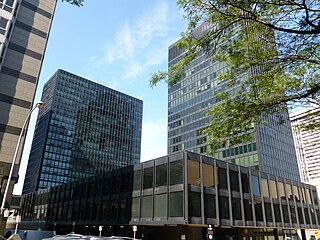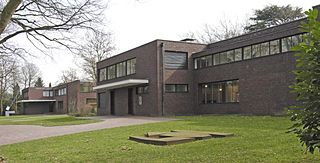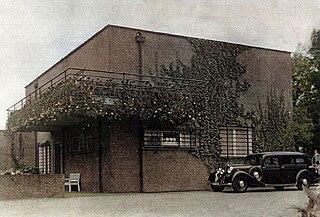
The Staatliches Bauhaus, commonly known as the Bauhaus, was a German art school operational from 1919 to 1933 that combined crafts and the fine arts. The school became famous for its approach to design, which attempted to unify the principles of mass production with individual artistic vision and strove to combine aesthetics with everyday function.

Ludwig Mies van der Rohe was a German-American architect. He was commonly referred to as Mies, his surname. Along with Alvar Aalto, Le Corbusier, Walter Gropius and Frank Lloyd Wright, he is regarded as one of the pioneers of modernist architecture.

Philip Cortelyou Johnson was an American architect best known for his works of modern and postmodern architecture. Among his best known designs are his modernist Glass House in New Canaan, Connecticut, and postmodern 550 Madison Avenue in New York, designed for AT&T, and 190 South La Salle Street in Chicago.

The Deutscher Werkbund is a German association of artists, architects, designers, and industrialists, established in 1907. The Werkbund became an important element in the development of modern architecture and industrial design, particularly in the later creation of the Bauhaus school of design. Its initial purpose was to establish a partnership of product manufacturers with design professionals to improve the competitiveness of German companies in global markets. The Werkbund was less an artistic movement than a state-sponsored effort to integrate traditional crafts and industrial mass production techniques, to put Germany on a competitive footing with England and the United States. Its motto Vom Sofakissen zum Städtebau indicates its range of interest.

The Barcelona Pavilion, designed by Ludwig Mies van der Rohe and Lilly Reich, was the German Pavilion for the 1929 International Exposition in Barcelona, Spain. This building was used for the official opening of the German section of the exhibition. It is an important building in the history of modern architecture, known for its simple form and its spectacular use of extravagant materials, such as marble, red onyx and travertine. The same features of minimalism and spectacular can be applied to the furniture specifically designed for the building, including the Barcelona chair. It has inspired many important modernist buildings.
The year 2007 in architecture involved some significant architectural events and new buildings.

The Neue Nationalgalerie at the Kulturforum is a museum for modern art in Berlin, with its main focus on the early 20th century. It is part of the National Gallery of the Berlin State Museums. The museum building and its sculpture gardens were designed by Ludwig Mies van der Rohe and opened in 1968.
The year 2005 in architecture involved some significant architectural events and new buildings.
Ludwig Karl Hilberseimer was a German architect and urban planner best known for his ties to the Bauhaus and to Mies van der Rohe, as well as for his work in urban planning at Armour Institute of Technology, in Chicago, Illinois.

Westmount Square is a residential and office complex located in Westmount, Quebec, Canada. There are two residential apartment buildings and two office buildings. These towers sit atop an underground shopping centre consisting of thirty-five shops. It is located between Saint Catherine Street and De Maisonneuve Boulevard and between Wood Avenue and Greene Avenue. It is connected to Place Alexis Nihon and the Atwater Metro station by a tunnel.

S. R. Crown Hall, designed by the German-American Modernist architect Ludwig Mies van der Rohe, is the home of the College of Architecture at the Illinois Institute of Technology in Chicago, Illinois.

James Ingo Freed was an American architect born in Essen, Germany during the Weimar Republic. After coming to the United States at age nine with his sister Betty, followed later by their parents, he studied at the Illinois Institute of Technology, where he graduated with a degree in architecture.

Expressionist architecture was an architectural movement in Europe during the first decades of the 20th century in parallel with the expressionist visual and performing arts that especially developed and dominated in Germany. Brick Expressionism is a special variant of this movement in western and northern Germany, as well as in the Netherlands.

Lilly Reich was a German modernist designer. She was a close collaborator with Ludwig Mies Van der Rohe for more than ten years in the late 1920s and '30s.
Neutelings Riedijk Architects is an architecture firm based in Rotterdam, the Netherlands, founded by Willem Jan Neutelings and Michiel Riedijk in 1987.

Haus Lange and Haus Esters are two residential houses designed by Ludwig Mies van der Rohe in Krefeld, Germany, for German industrialists Hermann Lange and Josef Esters. They were built between 1928 and 1930 in the Bauhaus style. The houses have now been converted into museums for Contemporary art.

The Lemke House on Oberseestraße 60 in the Berlin district of Alt-Hohenschönhausen is the last house designed by Ludwig Mies van der Rohe in Germany before his emigration to the United States in 1938. It was built in Bauhaus style at the beginning of the 1930s under the name Villa Lemke.

Villa Wolf was an architecturally significant building in Gubin, Poland, designed by the German architect Ludwig Mies van der Rohe. It is also known as Haus Wolf. The property was developed in Guben, Germany, between 1925 and 1926 – two decades before the Oder–Neisse line divided the city to create Gubin – for Erich and Elisabeth Wolf. It was one of the pioneering prototypes of modern architecture in Europe, and is considered the first modern work of Mies van der Rohe. It stood between two gardens parallel to the Lusatian Neisse river at Teichbornstraße 13 in today's Gubin, which at that time still belonged to Guben, but is now located in the Polish part of Lower Lusatia. It was destroyed during World War II in 1945 and there are plans to reconstruct it.
900 910 North Lake Shore are a pair of glass and steel buildings, perpendicular to one another, designed by architect Ludwig Mies van der Rohe, in the Streeterville neighborhood of Chicago. Completed in 1956, they marked the refinement of Mies' highrise building design concept. The buildings are built to a Modernist International style that was considered to be a departure from the dominant aesthetic at the time they were built, and even criticized as too minimal. The "glass houses" are more often appreciated for the views they offer of Lake Michigan and downtown Chicago. The buildings were referred to as “giant mirrors for lake beauty”.
The Mies Building for the Eskenazi School of Art, Architecture + Design is a building under construction on the campus of Indiana University. The building is based upon plans Mies van der Rohe created in 1952.













